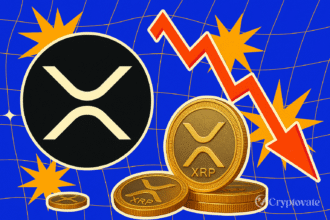In a financial landscape that is increasingly embracing cryptocurrencies, the demand for digital assets on the buy-side is surging to new heights. As expectations around initial public offerings (IPOs) reach unprecedented levels, investors are turning to cryptocurrencies as a potential game-changer. This article delves into the rise of crypto and explores the reasons behind its soaring demand, particularly from the buy-side. Cryptocurrencies have evolved from a fringe concept to a mainstream investment option, attracting both institutional and retail investors. The decentralization and security features offered by blockchain technology have positioned cryptocurrencies as a lucrative alternative to traditional financial instruments. As IPO expectations continue to drive investor enthusiasm, the demand for crypto has skyrocketed. This article uncovers the opportunities and challenges that emerge in this ever-evolving landscape by exploring the surging demand for cryptocurrencies on the buy-side and its implications on IPO expectations. As the crypto market continues to gain momentum, understanding its impact on the buy-side is crucial for investors and stakeholders alike.
Understanding the Buy-Side Market
The buy-side market comprises institutional investors, such as mutual funds, hedge funds, pension funds, and private equity firms, that buy large quantities of securities for investment purposes. Unlike the sell-side, which includes brokers and investment banks that facilitate trades, the buy-side focuses on investing for profit.
Key Players in the Buy-Side Market
- Mutual Funds: Pools of funds from multiple investors to purchase a diversified portfolio of assets.
- Hedge Funds: Utilize advanced strategies to achieve high returns, often involving significant risk.
- Pension Funds: Manage retirement savings for individuals, investing in various asset classes.
- Private Equity Firms: Invest in private companies, often taking active roles in management to enhance value.
Buy-Side Investment Strategies
- Active Management: Involves active decision-making to outperform the market.
- Passive Management: Focuses on replicating market indices to achieve similar returns.
- Quantitative Strategies: Use complex mathematical models to identify investment opportunities.
- Fundamental Analysis: Evaluates a company’s financial health and market position to make investment decisions.
The Surge in Demand for Cryptocurrencies
The demand for cryptocurrencies has surged, driven by several factors including technological innovation, market speculation, and increasing acceptance of digital assets.
Factors Contributing to Rising Demand
- Decentralization: Cryptocurrencies operate without central authorities, appealing to investors seeking autonomy from traditional financial systems.
- Innovation: Blockchain technology provides transparency, security, and efficiency, driving interest in cryptocurrencies.
- Market Speculation: High volatility attracts traders looking for significant returns, though it also increases risk.
- Institutional Adoption: More institutions are incorporating cryptocurrencies into their portfolios, lending legitimacy to the market.
Popular Cryptocurrencies
- Bitcoin (BTC): The first and most well-known cryptocurrency, often seen as digital gold.
- Ethereum (ETH): Known for its smart contract capabilities and applications beyond simple transactions.
- Ripple (XRP): Focuses on facilitating real-time, cross-border payment systems.
- Cardano (ADA): Emphasizes security and scalability through a layered architecture.
Factors Driving the Demand for Cryptocurrencies
Various factors fuel the rising demand for cryptocurrencies, from technological advances to changing financial paradigms.
Technological Advancements
- Blockchain Technology: Offers secure and transparent transaction records, underpinning the appeal of cryptocurrencies.
- Smart Contracts: Automate and enforce contract terms without intermediaries, reducing costs and enhancing efficiency.
- Decentralized Finance (DeFi): Enables financial services like lending and borrowing without traditional banks, broadening the appeal of crypto assets.
Economic Factors
- Inflation Hedge: Cryptocurrencies, particularly Bitcoin, are perceived as a hedge against inflation due to their limited supply.
- Global Financial Inclusion: Cryptocurrencies provide financial services to the unbanked population, especially in developing regions.
- Monetary Policy Impact: Loose monetary policies and low interest rates have driven investors toward alternative assets like cryptocurrencies.
Social and Cultural Trends
- Digital Adoption: The growing digitization of society supports the adoption of cryptocurrencies as digital-native assets.
- Millennial and Gen Z Interest: Younger generations, more comfortable with technology, are more likely to invest in cryptocurrencies.
- Celebrity Endorsements: High-profile endorsements and social media influence have also contributed to the mainstream appeal of cryptocurrencies.
IPO Expectations and Its Impact on the Crypto Market
Initial Public Offerings (IPOs) represent the traditional route for companies to raise capital by going public. However, the rise of cryptocurrencies offers an alternative for investors looking for high-growth opportunities.
IPO Dynamics
- Valuation Expectations: High expectations for IPO valuations can divert capital to more speculative markets like cryptocurrencies.
- Market Volatility: IPOs can introduce volatility in traditional markets, prompting investors to seek stability or high returns in crypto.
- Liquidity Events: Successful IPOs generate liquidity for investors, some of which may flow into the crypto market.
Cryptocurrencies as an Alternative
- Token Offerings: Cryptocurrencies and Initial Coin Offerings (ICOs) provide a decentralized way for companies to raise capital.
- Regulatory Environment: While IPOs are heavily regulated, cryptocurrencies often operate in a more flexible regulatory framework.
- Access to Capital: Cryptocurrencies democratize access to investment opportunities, allowing retail investors to participate in high-growth ventures typically reserved for institutional players.
The Role of Institutional Investors in the Crypto Market
Institutional Investment Strategies
Institutional investors, including hedge funds, mutual funds, and pension funds, are increasingly participating in the crypto market, which has significant implications for market dynamics and growth. Their involvement has transformed cryptocurrencies from a niche asset class to a legitimate component of diversified portfolios. Here’s how:
Direct Investment: Institutions are buying cryptocurrencies directly through exchanges or over-the-counter (OTC) transactions. This approach provides them with direct exposure to the price movements of digital assets.
Funds and Trusts: Products like Grayscale Bitcoin Trust (GBTC) or crypto exchange-traded funds (ETFs) offer a managed exposure to cryptocurrencies, appealing to institutions that prefer not to handle digital assets directly.
Futures and Derivatives: Using financial instruments such as Bitcoin futures, options, and other derivatives, institutions can hedge against volatility or gain exposure to cryptocurrencies without holding the assets themselves.
Venture Capital: Institutional investors are also funding blockchain startups and projects, betting on the growth of the technology and its applications.
Impact on Market Dynamics
The entry of institutional investors into the crypto market brings several notable changes:
Increased Liquidity: Large investments by institutions enhance market liquidity, making it easier to buy and sell cryptocurrencies without causing significant price swings.
- Market Maturity: Institutional involvement leads to more structured and professional trading practices, contributing to market stabilization and maturity.
Enhanced Security: Institutions demand robust security measures, driving the development of secure custodial solutions and reducing the risk of theft and fraud.
Price Discovery: The sophisticated trading strategies employed by institutional investors contribute to more accurate price discovery, reflecting the true market value of cryptocurrencies.
Challenges for Institutional Investors
Despite the growing interest, institutional investors face several hurdles in the crypto market:
Regulatory Uncertainty: The lack of clear regulatory guidelines can pose significant risks, making compliance challenging for institutions.
Custody Solutions: Secure storage solutions are critical for institutions managing large crypto holdings. The development of institutional-grade custodial services has become a priority.
Market Volatility: Cryptocurrencies are known for their volatility, which can deter risk-averse institutional investors despite the potential for high returns.

Regulatory Challenges and Their Influence on the Crypto Market
The rise of cryptocurrencies has posed significant regulatory challenges worldwide, compelling authorities to craft frameworks that balance innovation, investor protection, and financial stability. This article explores the global regulatory landscape for cryptocurrencies, delves into key regulatory issues, and examines the impact of these regulations on market behavior.
Global Regulatory Landscape
United States
Regulatory Agencies and Their Roles
- Securities and Exchange Commission (SEC):
- Mandate: Regulates securities markets.
- Crypto Involvement: The SEC has classified certain cryptocurrencies and Initial Coin Offerings (ICOs) as securities. This subjects them to stringent regulations, including registration requirements and compliance with federal securities laws.
- Impact: Increased compliance requirements for ICOs and tokens that meet the Howey Test for securities.
- Commodity Futures Trading Commission (CFTC):
- Mandate: Oversees commodity futures and options markets.
- Crypto Involvement: Treats cryptocurrencies like Bitcoin and Ether as commodities. Regulates trading of cryptocurrency derivatives.
- Impact: Facilitates the trading of Bitcoin futures and options, increasing market depth and legitimacy.
- Financial Crimes Enforcement Network (FinCEN):
- Mandate: Enforces laws against money laundering and terrorist financing.
- Crypto Involvement: Requires cryptocurrency exchanges to implement Anti-Money Laundering (AML) and Know Your Customer (KYC) procedures.
- Impact: Increased scrutiny and compliance costs for exchanges to prevent illicit activities.
- State-Level Regulation:
- Example: New York’s BitLicense requires businesses to obtain a license to operate with cryptocurrencies.
- Impact: Creates a patchwork of regulations that businesses must navigate, often leading to higher operational costs.
Regulatory Developments
- Recent Trends: The U.S. is moving towards more comprehensive crypto regulations, with proposed legislation aiming to clarify the status of digital assets and improve consumer protections.
- Future Outlook: Expect more regulatory clarity, especially regarding the classification of digital assets and the responsibilities of crypto service providers.
European Union
Regulatory Frameworks
- Markets in Crypto-Assets (MiCA):
- Mandate: Provides a unified regulatory framework for crypto-assets across the EU.
- Crypto Involvement: Addresses the regulation of stablecoins, token offerings, and crypto asset service providers.
- Impact: Standardizes rules across member states, enhancing legal clarity and market confidence.
- Anti-Money Laundering (AML) Directive:
- Mandate: Prevents money laundering and terrorist financing.
- Crypto Involvement: Extends AML requirements to crypto exchanges and wallet providers.
- Impact: Strengthens compliance and reduces the risk of illicit activities.
- European Securities and Markets Authority (ESMA):
- Mandate: Ensures the stability of the EU’s financial system.
- Crypto Involvement: Provides guidance on the classification and regulation of crypto-assets.
- Impact: Offers regulatory consistency and investor protection across the EU.
Regulatory Developments
- Recent Trends: The EU is focused on harmonizing crypto regulations to foster a more integrated market and protect consumers.
- Future Outlook: The implementation of MiCA and enhanced AML measures will likely drive greater regulatory uniformity and market growth.
Asia
Regulatory Diversity
- China:
- Mandate: Protects financial stability and curtails illicit activities.
- Crypto Involvement: Has banned cryptocurrency trading, ICOs, and mining.
- Impact: Limits the domestic market for cryptocurrencies, pushing activities offshore or into the informal economy.
- Japan:
- Mandate: Promotes a secure and regulated crypto market.
- Crypto Involvement: Recognizes Bitcoin as legal tender and has a licensing system for exchanges under the Financial Services Agency (FSA).
- Impact: Provides a regulated environment that encourages innovation while protecting consumers.
- Singapore:
- Mandate: Establishes a progressive regulatory regime for digital payments and cryptocurrencies.
- Crypto Involvement: The Payment Services Act regulates digital payment token services and provides a clear legal framework.
- Impact: Encourages growth in the fintech sector by offering regulatory certainty.
- South Korea:
- Mandate: Curb speculative trading and protect investors.
- Crypto Involvement: Implements strict AML and real-name verification requirements for exchanges.
- Impact: Reduces speculative trading and enhances transparency.
Regulatory Developments
- Recent Trends: Asian countries are either tightening regulations (China, South Korea) or providing more structured frameworks (Japan, Singapore).
- Future Outlook: Expect continued regulatory evolution, with a focus on balancing innovation and risk management.
Also Read: Decoding the Cryptocurrency Mystery: Understanding the Bitcoin Halving Cycle
Key Regulatory Issues
Anti-Money Laundering (AML)
Regulatory Requirements
- Identity Verification:
- Exchanges must verify customer identities through government-issued IDs and other documents.
- Impact: Increases operational costs and compliance complexity but reduces the risk of illicit activities.
- Transaction Monitoring:
- Continuous monitoring of transactions to detect suspicious activities.
- Impact: Enhances market integrity but requires robust technological solutions and expertise.
- Reporting Obligations:
- Requirement to report suspicious activities and large transactions to regulatory authorities.
- Impact: Promotes transparency but adds to the compliance burden for businesses.
Challenges and Solutions
- Challenges: Balancing privacy with regulatory requirements, managing the cost of compliance, and integrating AML procedures with decentralized platforms.
- Solutions: Adoption of advanced technologies for identity verification and transaction monitoring, and development of clear guidelines for decentralized finance (DeFi) platforms.
Securities Classification
Regulatory Frameworks
- Securities and Exchange Commission (SEC):
- Applies the Howey Test to determine if a crypto asset qualifies as a security.
- Impact: Subjects many ICOs and tokens to securities regulations, affecting their issuance and trading.
- Commodity Futures Trading Commission (CFTC):
- Classifies cryptocurrencies like Bitcoin as commodities.
- Impact: Allows trading of cryptocurrency derivatives but imposes regulations similar to other commodities.
Challenges and Solutions
- Challenges: Differentiating between utility tokens and securities, varying international standards, and the evolving nature of digital assets.
- Solutions: Development of clear classification criteria, international regulatory cooperation, and adaptive legal frameworks that can evolve with the market.
Taxation
Regulatory Frameworks
- Capital Gains Tax:
- Many jurisdictions treat crypto transactions as taxable events, subjecting them to capital gains tax.
- Impact: Requires meticulous tracking of transactions and cost basis.
- Income Tax:
- Cryptocurrencies received as payment or through mining may be subject to income tax.
- Impact: Adds complexity to tax reporting and compliance.
- Value Added Tax (VAT) and Sales Tax:
- Some countries apply VAT or sales tax to crypto transactions.
- Impact: Varies widely, affecting the cost and structure of transactions.
Challenges and Solutions
- Challenges: Lack of clear guidelines in many jurisdictions, complexity in tracking and reporting transactions, and differing international tax treatments.
- Solutions: Development of standardized tax reporting tools, clear regulatory guidelines, and international harmonization of tax treatments for digital assets.
Impact of Regulation on Market Behavior
Investor Protection
- Enhanced Confidence:
- Regulatory frameworks provide legal certainty and consumer protection, enhancing investor confidence.
- Impact: Attracts a broader range of participants, including institutional investors.
- Fraud Prevention:
- Regulations mandate disclosures, security measures, and dispute resolution mechanisms.
- Impact: Reduces the risk of fraud and improves market integrity.
Market Innovation
- Encouragement of Responsible Innovation:
- Well-crafted regulations support the development of new financial products while ensuring they meet safety and transparency standards.
- Impact: Fosters a dynamic market with innovative solutions like tokenized assets and DeFi platforms.
- Legal Clarity:
- Clear regulations help businesses understand compliance requirements, reducing uncertainty and encouraging investment in new technologies.
- Impact: Promotes growth and stability in the market.
Cross-Border Challenges
- Regulatory Arbitrage:
- Businesses may relocate to jurisdictions with more favorable regulations, creating inconsistencies and potential risks.
- Impact: Complicates global regulatory efforts and can undermine investor protections.
- Compliance Burden:
- Navigating varying regulations across jurisdictions increases operational complexity and costs for businesses.
- Impact: Hinders international expansion and market integration.
- International Cooperation:
- Harmonizing regulations across countries can reduce compliance burdens and facilitate global market participation.
- Impact: Promotes a more integrated and efficient global cryptocurrency market.
Investment Strategies for the Buy-Side in the Crypto Market
The cryptocurrency market offers numerous opportunities for buy-side investors, including institutions and high-net-worth individuals. Effective investment strategies are crucial for navigating this volatile and rapidly evolving landscape. This article explores key investment strategies for the buy-side in the crypto market, covering diversification, asset allocation, thematic investing, risk management, fundamental and technical analysis, and the differences between long-term and short-term strategies.
Diversification
Importance of Diversification
Diversification involves spreading investments across different assets to reduce risk. In the crypto market, where volatility is high, diversification can help mitigate the impact of adverse price movements in any single asset.
- Reduces Volatility: By holding a variety of cryptocurrencies, investors can smooth out returns and lessen the impact of extreme price swings in individual assets.
- Enhances Returns: Exposure to multiple assets increases the likelihood of capturing gains from high-performing cryptocurrencies.
Strategies for Diversification
- Across Asset Classes:
- Crypto Assets: Diversify among different types of cryptocurrencies, such as large-cap coins (e.g., Bitcoin, Ethereum), mid-cap, and small-cap altcoins.
- Traditional Assets: Include traditional assets like stocks, bonds, or commodities in a portfolio to balance crypto volatility.
- Across Sectors:
- Payment Tokens: Coins used for transactions (e.g., Bitcoin, Litecoin).
- Platform Tokens: Cryptos powering blockchain ecosystems (e.g., Ethereum, Solana).
- Stablecoins: Tokens pegged to traditional currencies (e.g., USDC, Tether) to reduce exposure to volatility.
- Geographic Diversification:
- Invest in cryptocurrencies from different regions to benefit from diverse regulatory environments and market dynamics.
Asset Allocation
Importance of Asset Allocation
Asset allocation determines how investments are distributed across various asset classes within a portfolio. In the crypto market, this involves balancing risk and return by assigning weights to different cryptocurrencies and related assets.
Strategies for Asset Allocation
- Strategic Allocation:
- Fixed Allocation: Set specific percentages for each asset class and periodically rebalance to maintain the target allocation.
- Dynamic Allocation: Adjust allocations based on market conditions, economic indicators, or changes in risk tolerance.
- Tactical Allocation:
- Short-term Adjustments: Make temporary shifts in asset allocation to capitalize on market opportunities or hedge against risks.
Example of Asset Allocation
- High-Risk Portfolio: 70% large-cap cryptocurrencies (e.g., Bitcoin, Ethereum), 20% mid-cap altcoins, 10% small-cap and emerging coins.
- Moderate-Risk Portfolio: 50% large-cap cryptocurrencies, 30% stablecoins, 20% mid-cap altcoins.
- Low-Risk Portfolio: 30% large-cap cryptocurrencies, 50% stablecoins, 20% bonds or other traditional assets.
Thematic Investing
What is Thematic Investing?
Thematic investing involves selecting assets based on specific themes or trends, such as technological innovation, environmental sustainability, or social impact. In the crypto market, thematic investing can target areas like decentralized finance (DeFi), non-fungible tokens (NFTs), or blockchain infrastructure.
Strategies for Thematic Investing
- Identify Trends:
- DeFi: Invest in tokens related to decentralized finance platforms (e.g., Uniswap, Aave).
- NFTs: Focus on cryptocurrencies involved in the NFT space (e.g., Ethereum, Flow).
- Web3: Select coins powering the next generation of decentralized internet applications (e.g., Polkadot, Chainlink).
- Evaluate Opportunities:
- Assess the potential for growth within a theme based on market trends, technological developments, and regulatory changes.
- Diversify Within Themes:
- Within each theme, diversify across different projects or platforms to spread risk.
Risk Management
Importance of Risk Management
Risk management is essential in the crypto market due to its high volatility and potential for significant losses. Effective risk management strategies help protect capital and achieve more stable returns.
Strategies for Risk Management
- Volatility Control:
- Position Sizing: Limit the size of individual investments relative to the overall portfolio to manage exposure to volatility.
- Hedging: Use derivatives or stablecoins to hedge against adverse price movements.
- Stop-Loss Orders:
- Definition: Stop-loss orders automatically sell an asset when it reaches a predetermined price, limiting losses.
- Application: Set stop-loss orders at strategic levels to protect against significant downturns while allowing for normal price fluctuations.
- Diversification:
- As mentioned earlier, diversification across different assets, sectors, and geographies helps reduce risk by spreading exposure.
Fundamental and Technical Analysis
Fundamental Analysis
Definition and Importance
Fundamental analysis evaluates the intrinsic value of a cryptocurrency by examining factors such as technology, use case, development team, market demand, and regulatory environment. It aims to determine whether a cryptocurrency is undervalued or overvalued based on its underlying attributes.
Key Metrics
- Technology and Innovation:
- Assess the blockchain’s technology, consensus mechanism, scalability, and security features.
- Development Team:
- Evaluate the expertise, track record, and commitment of the team behind the cryptocurrency.
- Adoption and Use Case:
- Analyze the real-world applications and user adoption of the cryptocurrency.
- Market Demand:
- Consider the demand for the cryptocurrency in various sectors and its potential for growth.
- Regulatory Environment:
- Evaluate how regulations may impact the cryptocurrency’s future viability and compliance requirements.
Technical Analysis
Definition and Importance
Technical analysis involves analyzing historical price data and trading volumes to predict future price movements. It relies on charts and statistical indicators to identify patterns and trends.
Key Techniques
- Chart Patterns:
- Identify patterns such as head and shoulders, double tops and bottoms, and triangles to predict future price movements.
- Indicators:
- Use indicators like moving averages, Relative Strength Index (RSI), and Bollinger Bands to gauge market momentum and potential reversal points.
- Volume Analysis:
- Analyze trading volume to confirm trends and identify potential entry and exit points.
- Support and Resistance Levels:
- Identify key price levels where the cryptocurrency tends to find support or resistance, helping to set strategic buy and sell points.
Long-Term vs. Short-Term Strategies
Long-Term Strategy: HODLing
Definition
“HODLing” refers to the long-term strategy of holding onto cryptocurrencies regardless of market fluctuations, based on the belief in their long-term value and potential for significant appreciation.
Benefits
- Reduced Transaction Costs:
- Minimizes trading fees and tax implications associated with frequent transactions.
- Capitalizes on Long-Term Growth:
- Benefits from the long-term appreciation of assets as the market matures and adoption increases.
- Less Stressful:
- Reduces the need for constant monitoring and active trading, aligning with a long-term investment horizon.
Drawbacks
- Volatility:
- Requires enduring significant price volatility and market downturns.
- Opportunity Cost:
- May miss out on short-term trading opportunities that could enhance returns.
Short-Term Strategy: Day Trading
Definition
Day trading involves buying and selling cryptocurrencies within short time frames (often within a single day) to capitalize on price fluctuations.
Benefits
- Quick Profits:
- Can generate quick returns from price movements within a short period.
- Exploits Volatility:
- Takes advantage of the high volatility in the crypto market to make frequent trades.
- Active Engagement:
- Provides opportunities for active management and decision-making based on market conditions.
Drawbacks
- High Transaction Costs:
- Involves frequent trading fees and potential tax implications.
- Time-Consuming:
- Requires constant monitoring and quick decision-making, which can be stressful and time-intensive.
- Risk of Losses:
- High potential for losses due to the market’s unpredictability and the fast-paced nature of trading.
Risks and Challenges Associated with Investing in Cryptocurrencies
Investing in cryptocurrencies presents unique risks and challenges that distinguish this asset class from traditional investments. Understanding these risks is crucial for investors aiming to navigate the volatile and dynamic crypto market. This article explores the major risks and challenges associated with investing in cryptocurrencies, including market volatility, regulatory risks, security concerns, technological risks, market manipulation, and psychological risks.
Market Volatility
Price Swings
Nature of Volatility
Cryptocurrencies are notorious for their extreme price volatility, which can lead to significant gains or losses over short periods. Unlike traditional assets, crypto prices can fluctuate wildly due to factors such as speculative trading, market sentiment, and news events.
Examples
- Bitcoin’s Price Fluctuations:
- Bitcoin, the largest cryptocurrency by market cap, has experienced dramatic price swings. For instance, Bitcoin surged from around $10,000 in September 2020 to over $60,000 by April 2021, only to drop below $30,000 by July 2021.
- Altcoin Volatility:
- Smaller cryptocurrencies or “altcoins” can be even more volatile. An altcoin might rise by hundreds of percent in a few days due to hype or a specific announcement, only to crash just as quickly when the excitement fades.
Market Sentiment
Impact of Sentiment
Market sentiment significantly influences cryptocurrency prices. Positive news, such as institutional adoption or favorable regulatory developments, can drive prices up, while negative news, such as regulatory crackdowns or security breaches, can cause sharp declines.
Examples
- Elon Musk’s Influence:
- Tweets and public statements by influential figures like Elon Musk have led to substantial price movements in cryptocurrencies like Bitcoin and Dogecoin.
- Regulatory News:
- Announcements of regulatory investigations or bans in major markets can cause panic selling and substantial price drops across the crypto market.
Regulatory Risks
Changing Regulations
Regulatory Uncertainty
The regulatory landscape for cryptocurrencies is continually evolving. Governments and regulatory bodies worldwide are still developing frameworks for overseeing cryptocurrency activities, leading to uncertainty that can affect market stability and investor confidence.
Examples
- SEC Investigations:
- The U.S. Securities and Exchange Commission (SEC) has initiated investigations into various cryptocurrency projects and exchanges, causing market uncertainty and price volatility.
- Global Regulatory Approaches:
- Countries like China have implemented strict bans on cryptocurrency trading and mining, while others like El Salvador have embraced Bitcoin as legal tender. These varying approaches create an unpredictable environment for investors.
Compliance Costs
Financial and Operational Burden
Complying with regulatory requirements can impose significant costs on cryptocurrency businesses and investors. These costs can include legal fees, reporting obligations, and technological upgrades to meet compliance standards.
Examples
- AML and KYC Compliance:
- Exchanges and financial institutions must implement Anti-Money Laundering (AML) and Know Your Customer (KYC) procedures, which can be costly and complex, potentially deterring new entrants and increasing operational costs.
- Tax Reporting:
- Investors must comply with tax reporting requirements for cryptocurrency transactions, which can be burdensome given the complexity of tracking cost bases, capital gains, and losses.
Security Concerns
Hacks and Scams
Prevalence of Cyber Attacks
The cryptocurrency market has been a target for numerous hacks and scams, resulting in significant losses for investors. Security breaches of exchanges, wallet providers, and even smart contracts have exposed vulnerabilities in the ecosystem.
Examples
- Exchange Hacks:
- Major exchanges like Mt. Gox and Bitfinex have suffered large-scale hacks, resulting in the loss of millions of dollars worth of cryptocurrencies.
- Phishing Scams:
- Scammers often use phishing attacks to steal private keys or login credentials, enabling them to access and drain investors’ wallets.
Custodial Risks
Risks with Third-Party Custodians
Investors who store their cryptocurrencies with third-party custodians, such as exchanges or wallet services, face the risk of losing access to their funds if the custodian is compromised or goes bankrupt.
Examples
- QuadrigaCX Incident:
- The Canadian exchange QuadrigaCX collapsed after the death of its founder, who was the only one with access to the exchange’s cold wallets, leading to the loss of customer funds.
- Regulatory Seizures:
- Regulatory authorities can seize assets held by custodians in the event of legal issues, potentially resulting in loss of funds for investors.
Technological Risks
Blockchain Vulnerabilities
Inherent Flaws
Blockchain technology, while innovative, is not immune to flaws and vulnerabilities. Issues such as coding errors, bugs, and design flaws can undermine the security and functionality of blockchain networks.
Examples
- DAO Hack:
- The DAO, a decentralized autonomous organization on the Ethereum blockchain, was hacked in 2016 due to a vulnerability in its smart contract code, resulting in the theft of approximately $60 million worth of Ether.
- 51% Attacks:
- Smaller blockchains are susceptible to 51% attacks, where a malicious actor gains control of the majority of the network’s mining power, allowing them to alter transactions and double-spend coins.
Scalability Issues
Network Congestion
Scalability remains a significant challenge for many blockchain networks, leading to issues such as network congestion, high transaction fees, and slow processing times during periods of high demand.
Examples
- Ethereum’s Gas Fees:
- During periods of high demand, transaction fees (known as “gas” fees) on the Ethereum network can skyrocket, making it costly to execute transactions or interact with smart contracts.
- Bitcoin’s Transaction Times:
- Bitcoin’s network can become congested during market surges, resulting in longer transaction confirmation times and increased fees.
Interoperability
Compatibility Challenges
Interoperability refers to the ability of different blockchain networks to communicate and interact with each other. Lack of interoperability can limit the functionality and adoption of blockchain technologies.
Examples
- Cross-Chain Transactions:
- Transferring assets between different blockchain networks (e.g., Bitcoin to Ethereum) often requires intermediaries or complex mechanisms, creating barriers and inefficiencies.
- DeFi Integration:
- Decentralized finance (DeFi) platforms on different blockchains may struggle to integrate seamlessly, limiting the development of cross-chain financial applications.
Market Manipulation
Pump and Dump Schemes
Nature of Manipulation
Pump and dump schemes involve artificially inflating the price of a cryptocurrency through coordinated buying or misleading information, followed by a rapid sell-off to profit from the elevated prices, leaving unsuspecting investors with losses.
Examples
- Coordinated Pumps:
- Groups on social media platforms organize pumps by collectively buying low-cap cryptocurrencies and promoting them, only to sell en masse once the price has surged.
- Fake News:
- Spreading false news or rumors about a cryptocurrency to manipulate its price, either by creating hype or by sowing fear.
Whale Influence
Impact of Large Holders
“Whales” are individuals or entities that hold significant amounts of a cryptocurrency. Their large trades can heavily influence the market, leading to sharp price movements and potential market manipulation.
Examples
- Large Sell Orders:
- When a whale sells a large amount of a cryptocurrency, it can trigger a market-wide sell-off, leading to a rapid price decline.
- Accumulation Strategies:
- Whales may accumulate large positions over time, gradually driving up the price and creating buying pressure, only to sell at peak prices.
Psychological Risks
FOMO (Fear of Missing Out)
Impact on Decision-Making
FOMO refers to the fear of missing out on potential profits, leading investors to make impulsive decisions, such as buying at peak prices or entering trades without proper analysis.
Examples
- Buying During Hype:
- Investors often rush to buy cryptocurrencies during periods of hype or market euphoria, leading to overvaluation and subsequent losses when the hype subsides.
- Chasing Trends:
- FOMO can drive investors to chase trending coins without considering the underlying fundamentals, increasing the risk of investing in overhyped or unsustainable projects.
Overconfidence
Impact on Risk Management
Overconfidence can lead investors to overestimate their ability to predict market movements or understand the intricacies of cryptocurrencies, resulting in inadequate risk management and potentially significant losses.
Examples
- Excessive Leverage:
- Overconfident investors might use excessive leverage in their trades, amplifying their potential losses if the market moves against them.
- Ignoring Risks:
- Believing that they have superior insight, some investors may ignore warning signs or fail to diversify their portfolios, leading to concentration risk and increased exposure to market downturns.
Conclusion: The Future of Cryptocurrencies and the Buy-Side Market
The landscape of cryptocurrencies and their role in the buy-side market has evolved dramatically over the past decade, with ongoing advancements and challenges shaping their future trajectory. In this concluding section, we delve into the key aspects influencing the future of cryptocurrencies and the buy-side market: the evolution of cryptocurrencies, institutional integration, regulatory developments, buy-side market adaptations, and the long-term outlook.
Evolution of Cryptocurrencies
Technological Advancements
Blockchain Innovations
The underlying blockchain technology has seen significant innovations, including the development of more efficient consensus mechanisms, such as Proof of Stake (PoS) and sharding, aimed at enhancing scalability, security, and speed of transactions.
Examples:
- Ethereum 2.0: Transitioning from Proof of Work (PoW) to PoS, Ethereum 2.0 aims to improve scalability and energy efficiency.
- Layer 2 Solutions: Technologies like the Lightning Network for Bitcoin and Rollups for Ethereum enhance transaction throughput and reduce fees.
Smart Contracts and DeFi
Smart contracts and decentralized finance (DeFi) have introduced new functionalities and applications for cryptocurrencies, allowing for complex financial transactions, lending, and trading to occur without intermediaries.
Examples:
- DeFi Platforms: Protocols like Uniswap, Aave, and Compound facilitate decentralized trading, lending, and borrowing.
- NFTs: Non-fungible tokens (NFTs) represent unique digital assets on the blockchain, revolutionizing the concept of ownership and digital art.
Increasing Adoption
Retail and Institutional Adoption
The adoption of cryptocurrencies has broadened from retail investors to significant institutional players, driven by the promise of high returns and diversification benefits.
Examples:
- Retail Usage: Platforms like PayPal and Square have enabled cryptocurrency transactions, increasing accessibility for retail users.
- Institutional Investment: Companies like MicroStrategy and Tesla have made substantial investments in Bitcoin, while traditional financial institutions are offering crypto-related products.
Institutional Integration
Expansion into Traditional Finance
Asset Management and ETFs
Institutional integration of cryptocurrencies into traditional finance has led to the creation of cryptocurrency investment products such as exchange-traded funds (ETFs) and mutual funds, providing traditional investors with exposure to this new asset class.
Examples:
- Bitcoin ETFs: The approval of Bitcoin ETFs in various markets has allowed investors to gain exposure to Bitcoin without directly holding the asset.
- Crypto Mutual Funds: Funds focusing on a diversified portfolio of cryptocurrencies are becoming more common.
Custodial Services
Institutions are developing and adopting sophisticated custodial solutions to securely manage and store cryptocurrency assets, addressing concerns about security and regulatory compliance.
Examples:
- Fidelity Digital Assets: Provides custody services for institutional investors in cryptocurrencies.
- Coinbase Custody: Offers secure storage solutions for large amounts of cryptocurrency.
Integration with Payment Systems
Payment Processing
Cryptocurrencies are increasingly being integrated into payment systems, allowing for faster and more efficient transactions. Major payment processors and financial institutions are exploring blockchain-based solutions to streamline cross-border payments and reduce costs.
Examples:
- Visa and Mastercard: Both have announced plans to support cryptocurrency transactions on their networks.
- RippleNet: Uses blockchain technology to facilitate real-time cross-border payments for financial institutions.
Regulatory Developments
Evolving Regulatory Frameworks
Clearer Guidelines
As cryptocurrencies gain prominence, regulators worldwide are working on establishing clearer guidelines to address issues such as investor protection, anti-money laundering (AML), and securities classification.
Examples:
- U.S. SEC and CFTC: Providing guidance on the classification and regulation of cryptocurrencies as securities or commodities.
- EU MiCA: The Markets in Crypto-Assets (MiCA) regulation aims to create a comprehensive regulatory framework for cryptocurrencies in the European Union.
Impact on Market Behavior
Regulatory clarity can enhance market stability and investor confidence, potentially leading to increased participation from institutional and retail investors alike. However, stringent regulations can also pose challenges, such as increased compliance costs and operational constraints.
Examples:
- KYC and AML: Enhanced regulations for KYC and AML can reduce illicit activities but increase compliance burdens for businesses.
- Taxation Policies: Clear taxation guidelines can help investors better understand their obligations, reducing the risk of legal complications.
Buy-Side Market Adaptations
Investment Strategies
Diversification and Risk Management
Buy-side market participants are adapting their strategies to include cryptocurrencies in their portfolios, focusing on diversification, risk management, and incorporating both traditional and novel analytical approaches.
Examples:
- Crypto Funds: Investment funds dedicated to cryptocurrencies use various strategies, including long-term holding, short-term trading, and algorithmic trading.
- Hedge Funds: Some hedge funds incorporate cryptocurrencies as part of their broader strategy to enhance returns and manage risk.
Analytical Tools
The development of sophisticated analytical tools and platforms helps buy-side investors better understand and navigate the cryptocurrency market, utilizing both fundamental and technical analysis.
Examples:
- On-Chain Analysis: Tools that analyze blockchain data to provide insights into market trends and investor behavior.
- Sentiment Analysis: Platforms that use social media and news data to gauge market sentiment and predict price movements.
Adoption of Technology
Blockchain Integration
Buy-side firms are exploring ways to integrate blockchain technology into their operations, from improving settlement processes to enhancing transparency and reducing costs.
Examples:
- Blockchain for Settlements: Using blockchain for faster and more secure transaction settlements.
- Smart Contracts for Derivatives: Employing smart contracts to automate and streamline derivatives trading.
Long-Term Outlook
Sustainable Growth
Innovation and Regulation Balance
The long-term outlook for cryptocurrencies depends on achieving a balance between innovation and regulation. While technological advancements will continue to drive the development of new applications and use cases, appropriate regulatory frameworks are essential to ensure market stability and protect investors.
Examples:
- Scalability Solutions: Continued efforts to address scalability challenges through Layer 2 solutions and improved consensus mechanisms.
- Regulatory Harmonization: International cooperation on regulatory standards can reduce cross-border challenges and facilitate global adoption.
Institutional and Retail Synergy
The synergy between institutional and retail investors will play a crucial role in the sustainable growth of the cryptocurrency market. As institutional involvement increases, it can bring more legitimacy, liquidity, and stability to the market, benefiting all participants.
Examples:
- Institutional Infrastructure: Development of robust infrastructure, such as custodial services and regulatory-compliant exchanges, supports broader adoption.
- Retail Innovation: Retail investors continue to drive innovation by experimenting with new applications, such as DeFi and NFTs.
Future Trends
Emerging Technologies
Emerging technologies, such as decentralized autonomous organizations (DAOs), privacy-focused coins, and quantum-resistant cryptography, will likely shape the future landscape of cryptocurrencies, offering new opportunities and challenges.
Examples:
- DAOs: Decentralized organizations that operate without centralized control, using blockchain-based governance mechanisms.
- Privacy Coins: Cryptocurrencies like Monero and Zcash focus on enhanced privacy and anonymity for transactions.
Market Maturation
As the cryptocurrency market matures, we can expect increased integration with traditional financial systems, more sophisticated financial products, and greater acceptance by mainstream investors and businesses.
Examples:
- Crypto Banking: Traditional banks offering cryptocurrency-related services, such as custody and lending.
- Institutional Products: Development of more complex financial products, such as crypto derivatives and ETFs.
Conclusion
The future of cryptocurrencies and the buy-side market is poised for continued evolution, driven by technological advancements, increased institutional integration, evolving regulatory frameworks, and strategic adaptations by market participants. While challenges remain, such as regulatory uncertainties and market volatility, the potential for innovation and growth in the cryptocurrency space is substantial. By embracing new technologies, navigating regulatory landscapes, and developing robust investment strategies, buy-side investors can position themselves to capitalize on the opportunities presented by this dynamic and rapidly evolving market.
FAQs
What is the buy-side market in finance?
The buy-side market consists of institutional investors who purchase securities for investment purposes, including mutual funds, hedge funds, pension funds, and private equity firms.
Why is there a surge in demand for cryptocurrencies?
The demand for cryptocurrencies is driven by factors such as technological innovation, market speculation, increasing institutional adoption, and the desire for decentralized financial systems.
How do IPO expectations influence the cryptocurrency market?
High IPO valuations and market volatility can drive investors towards cryptocurrencies as alternative high-growth opportunities, while successful IPOs may also inject liquidity into the crypto market.
What role do institutional investors play in the crypto market?
Institutional investors provide significant liquidity, bring market maturity, and enhance security, though they also face challenges like regulatory uncertainty and the need for secure custody solutions.
What are the main regulatory challenges in the crypto market?
Regulatory challenges include anti-money laundering compliance, securities classification, and taxation, with varying regulations across different countries impacting the market.
What are some effective investment strategies for the buy-side in the crypto market?
Effective strategies include diversification, risk management through volatility control and stop-loss orders, fundamental and technical analysis, and balancing long-term and short-term investment approaches.
What are the risks associated with investing in cryptocurrencies?
Risks include market volatility, regulatory changes, security concerns like hacks and scams, technological issues such as blockchain vulnerabilities, market manipulation, and psychological factors like FOMO and overconfidence.













